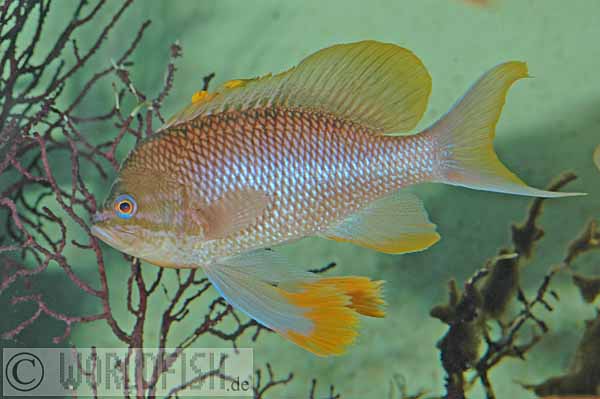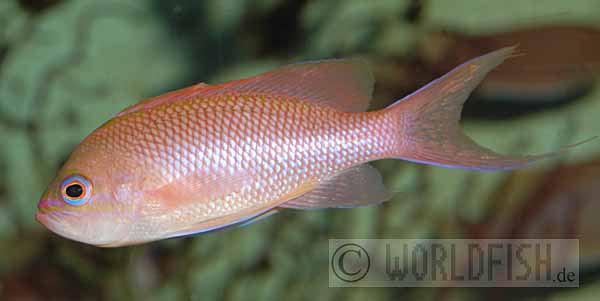Anthias anthias: Unterschied zwischen den Versionen
Es (Diskussion | Beiträge) (→vor 1900) |
Es (Diskussion | Beiträge) (→2000-) |
||
| (5 dazwischenliegende Versionen desselben Benutzers werden nicht angezeigt) | |||
| Zeile 29: | Zeile 29: | ||
<!--------------------------- Platz für Abbildungen --------------------------> | <!--------------------------- Platz für Abbildungen --------------------------> | ||
| style="width:50%; padding:0 1em; background:#f5fffa; border:1px solid #ccc;" id=mf-sow| | | style="width:50%; padding:0 1em; background:#f5fffa; border:1px solid #ccc;" id=mf-sow| | ||
| − | + | [[Datei:Anthias anthias 0056.jpg|600px|thumb|left|''Anthias anthias'' ♂ -- (C) {{a|Erwin Schraml}}]] | |
| + | [[Datei:Anthias anthias 0060.jpg|600px|thumb|left|''Anthias anthias'' ♀ -- (C) {{a|Erwin Schraml}}]] | ||
|} | |} | ||
== Typen == | == Typen == | ||
| − | ''' | + | '''Keine Typusexemplare bekannt.'''<br /> |
Siehe: [http://researcharchive.calacademy.org/research/ichthyology/catalog/fishcatget.asp?spid=19602 {{aut|Eschmeyer, W.N., Fricke, R. & Van der Laan, R.}} (eds.) {{CURRENTYEAR}}. ''Catalog of Fishes'' electronic version]<br /> | Siehe: [http://researcharchive.calacademy.org/research/ichthyology/catalog/fishcatget.asp?spid=19602 {{aut|Eschmeyer, W.N., Fricke, R. & Van der Laan, R.}} (eds.) {{CURRENTYEAR}}. ''Catalog of Fishes'' electronic version]<br /> | ||
| − | '''Typusfundort:''' . | + | '''Typusfundort:''' Südliches Europa, Mittelmeer. |
== Etymologie == | == Etymologie == | ||
| Zeile 40: | Zeile 41: | ||
== Verbreitung == | == Verbreitung == | ||
| − | . | + | Mittelmeer, Adria, Atlantik: von Portugal bis Angola, einschließlich Azoren und Madeira. |
== IUCN Status == | == IUCN Status == | ||
| Zeile 76: | Zeile 77: | ||
{{Bloch, 1792}}[:99, Pl. 315, <span style="color: red">'''!!'''</span> als ''[[Anthias sacer]]''] | {{Bloch, 1792}}[:99, Pl. 315, <span style="color: red">'''!!'''</span> als ''[[Anthias sacer]]''] | ||
{{Suckow, 1799}}[:535, <span style="color: red">'''!!'''</span> als ''[[Holocentrus pennanti]]''] | {{Suckow, 1799}}[:535, <span style="color: red">'''!!'''</span> als ''[[Holocentrus pennanti]]''] | ||
| − | {{Cuvier, 1828}}[: , Autor: {{aut|Bloch}}, als ''[[Perca pennanti]]''] | + | {{Cuvier & Valenciennes, 1828}}[: , Autor: {{aut|Bloch}}, als ''[[Perca pennanti]]''] |
{{Guichenot, 1868}}[:81 [2], <span style="color: red">'''!!'''</span> als ''[[Aylopon hispanus]]''; :81 [2], <span style="color: red">'''!!'''</span>, als ''[[Aylopon ivicae]]''; :82 [3], <span style="color: red">'''!!'''</span> als ''[[Aylopon rissoi]]'';:83 [4], <span style="color: red">'''!!'''</span> als ''[[Aylopon nicaeensis]]'';:84 [5], <span style="color: red">'''!!'''</span> als ''[[Aylopon algeriensis]]''; , :84, <span style="color: red">'''!!'''</span> als ''[[Aylopon canariensis]]''] | {{Guichenot, 1868}}[:81 [2], <span style="color: red">'''!!'''</span> als ''[[Aylopon hispanus]]''; :81 [2], <span style="color: red">'''!!'''</span>, als ''[[Aylopon ivicae]]''; :82 [3], <span style="color: red">'''!!'''</span> als ''[[Aylopon rissoi]]'';:83 [4], <span style="color: red">'''!!'''</span> als ''[[Aylopon nicaeensis]]'';:84 [5], <span style="color: red">'''!!'''</span> als ''[[Aylopon algeriensis]]''; , :84, <span style="color: red">'''!!'''</span> als ''[[Aylopon canariensis]]''] | ||
{{Bellotti, 1879}}[:36 [4], <span style="color: red">'''!!'''</span> als ''[[Anthias sacer brevipes]]''] | {{Bellotti, 1879}}[:36 [4], <span style="color: red">'''!!'''</span> als ''[[Anthias sacer brevipes]]''] | ||
| Zeile 99: | Zeile 100: | ||
{{PAT04a}}[:53f|Farbfoto, Vorkommen, Ökologie, Fortpflanzung ]<br /> | {{PAT04a}}[:53f|Farbfoto, Vorkommen, Ökologie, Fortpflanzung ]<br /> | ||
{{Parenti & Randall, 2020}}[: 8, Verbreitung, Synonyme, Checkliste] | {{Parenti & Randall, 2020}}[: 8, Verbreitung, Synonyme, Checkliste] | ||
| + | {{González-Lorenzo et al., 2021}}[:145] | ||
===Links=== | ===Links=== | ||
Aktuelle Version vom 26. Juli 2021, 17:05 Uhr
(Linnaeus, 1758)
|
Familie: Serranidae SynonymeLabrus anthias Linnaeus, 1758
Anthias sacer Bloch, 1792
Aylopon algeriensis Guichenot, 1868 Lokale Bezeichnung |
 Anthias anthias ♂ -- (C) Erwin Schraml  Anthias anthias ♀ -- (C) Erwin Schraml |
Typen
Keine Typusexemplare bekannt.
Siehe: Eschmeyer, W.N., Fricke, R. & Van der Laan, R. (eds.) 2024. Catalog of Fishes electronic version
Typusfundort: Südliches Europa, Mittelmeer.
Etymologie
.
Verbreitung
Mittelmeer, Adria, Atlantik: von Portugal bis Angola, einschließlich Azoren und Madeira.
IUCN Status
|
LC Least Concern (nicht gefährdet) Mögliche Gefahren für diese Art: Keine größeren Gefahren bekannt; kein Populationsrückgang bekannt. |
EX Extinct (ausgestorben) EW Extinct in the Wild (in der Natur ausgestorben) CR Critically Endangered (vom Aussterben bedroht) EN Endangered (stark gefährdet) VU Vulnerable (gefährdet) NT Near Threatened (potenziell gefährdet) LC Least Concern (nicht gefährdet) RE Regionally Extinct (regional oder national ausgestorben) |
Literatur
vor 1900
- Linnaeus, C. 1758. Systema naturae per regna tria naturae, secundum classes, ordines, genera, species, cum characteribus, differentiis, synonymis, locis. Editio Decima, Reformata. Tomus I. Laurentii Salvii, Stockholm. 824 pp. (doi) Zitatseite [: 282, !! als Labrus anthias]
- Bloch, M.E. 1792. Naturgeschichte der ausländischen Fische. Berlin. 6: i-xii + 1-126, Pls. 289-323. Zitatseite [:99, Pl. 315, !! als Anthias sacer]
- Suckow, G.A. 1799. Anfangsgründe der theoretischen und angewandten Naturgeschichte der Thiere. 4 vols. Weidmannische Buchhandlung, Leipzig. 4, pt. 1: 1-374; pt. 2: pp. 375-880. (BHL) Zitatseite [:535, !! als Holocentrus pennanti]
- Cuvier, G. & Valenciennes, A. 1828. Histoire naturelle des poissons. Tome second. Livre Troisième. Des poissons de la famille des perches, ou des percoïdes. 2: i-xxi + 2 pp. + 1-490, Pls. 9-40. (BHL) Zitatseite [: , Autor: Bloch, als Perca pennanti]
- Guichenot, A. 1868. Index generum ac specierum Anthiadidorum hucusque in Museo Parisiensis observatorum. Annales de la Société Linnéenne du Département de Maine-et-Loire, 10: 80-87. Zitatseite [:81 [2], !! als Aylopon hispanus; :81 [2], !!, als Aylopon ivicae; :82 [3], !! als Aylopon rissoi;:83 [4], !! als Aylopon nicaeensis;:84 [5], !! als Aylopon algeriensis; , :84, !! als Aylopon canariensis]
- Bellotti, C. 1879. Note ittiologiche. Osservazioni fatte sulla collezione ittiologica del civico Museo di Storia Naturale in Milano. IV. -- Sul Gadiculus argenteus Guich. Atti della Società Italiana di Scienze Naturali di Milano, 22: 33-38. Zitatseite [:36 [4], !! als Anthias sacer brevipes]
- Johnson, J.Y. 1890. On some new species of fishes from Madeira. Proceedings of the Zoological Society of London, 1890 (2) (art. 5): 452-459. Zitatseite [: 452, !! als Anthias mundulus]
1970-1999
- Stöhr, H. 1972. Der heilige Fisch der Schwammtaucher. Tatsachen und Informationen aus der Aquaristik (TI), #18, 6 (2): 9-10. Zitatseite [:9-10|Aquarienhaltung, (Farbfoto, ?) ]
- Probst, K. 1973. Zum Roten Fahnenbarsch Anthias anthias. Tatsachen und Informationen aus der Aquaristik (TI), #21: 18. Zitatseite [:18|gelistet ]
- Tortonese, E. 1973. [Darstellung verschiedener Familien] In:
- Hureau, J.-C. & Monod, T. 1973. Check-list of the Fishes of the North-eastern Atlantic and of the Mediterranean. CLOFNAM. Unesco, Paris. v. 1: i-xxii + 1-683. Zitatseite [:356, als Anthias anthias]
- Lythgoe, J. & Lythgoe, G. 1974. Meeresfische - Nordatlantik und Mittelmeer. BLV Verlagsgesellschaft, München, Bern, Wien. Zitatseite [:191f|Farbfoto, Beschreibung, Vorkommen ]
- Brockmann, D. 1981. Meine Erfahrungen mit Fahnenbarschen. Mirolabrichthys evansi und Anthias anthias. Das Aquarium, #140, (2): 84-86. Zitatseite [:84ff|Farbfoto, Aquarienhaltung ]
- Debelius, H. 1984. Kleine Barsche - groß betrachtet. 3. Teil: Fahnenbarsche. Die Aquarien- und Terrarienzeitschrift (DATZ), 37 (9): 345-350. Zitatseite [:347*|Farbfoto ]
- Whitehead, P.J.P., Bauchot, M.-L., Hureau, J.-C., Nielsen, J. & Tortonese, E. 1986. Fishes of the North-eastern Atlantic and the Mediterranean. Volume II. pp. 517-1007. Paris: Unesco, 1986. Zitatseite [:781|Zeichnung, Beschreibung, Vorkommen, Synonyme ]
- Wirtz, P. 1991. Die Küstenfische der Azoren. Die Aquarien- und Terrarienzeitschrift (DATZ), 44 (2): 103-105. Zitatseite [:104|Farbfoto, Vorkommen ]
- Costa, F. 1991. Atlante dei pesci dei mari italiani. Verlag: Mursia, Milano. Zitatseite [:68f|Farbfoto, Beschreibung ]
- Baumeister, W. 1992. Isola di Giannutri. Die Aquarien- und Terrarienzeitschrift (DATZ), 45 (6): 378-381. Zitatseite [:380f|Farbfoto, Vorkommen ]
- Heimig, D. 1992. Leben in der "Wüste" des Mittelmeeres. Das Aquarium, #277, (Juli): 31-32. Zitatseite [:31f|Farbfoto ]
- Göthel, H. 1992. Farbatlas Mittelmeefauna / Niedere Tiere und Fische. Ulmer Verlag Stuttgart. Zitatseite [:250|Farbfoto, Ökologie, Fortpflanzung ]
- Baensch, H.A. & Debelius, H. 1992. Meerwasser-Atlas Band 1. Mergus-Verlag, Melle. 1. Auflage. Zitatseite [:934f|Farbfoto ]
2000-
- Patzner, R.A. & Moosleitner, H. 2004. Die Sägebarsche des Mittelmeeres. Teil 2 (Schluss) : Kleine Sägebarsche und Fahnenbarsche. Das Aquarium, #422, (8): 49-54. Zitatseite [:53f|Farbfoto, Vorkommen, Ökologie, Fortpflanzung ]
- Parenti, P. & Randall, J.E. 2020. An annotated checklist of the fishes of the family Serranidae of the world with description of two new related families of fishes. FishTaxa, 5 (1): 1-170. Zitatseite [: 8, Verbreitung, Synonyme, Checkliste]
- González-Lorenzo, G., González-Jiménez, J.F. & González, J.A. 2021. Review of the family Serranidae (Perciformes) from the Canary Islands (eastern-central Atlantic), with the first records of Serranus hepatus and Epinephelus aeneus. Cybium, 45 (2): 141-154. (doi) Zitatseite [:145]
